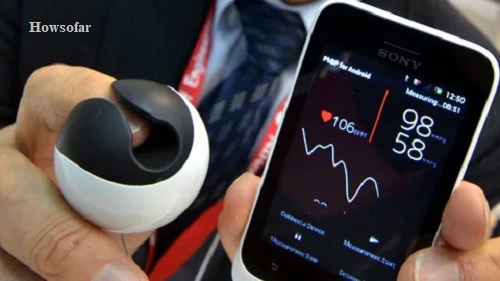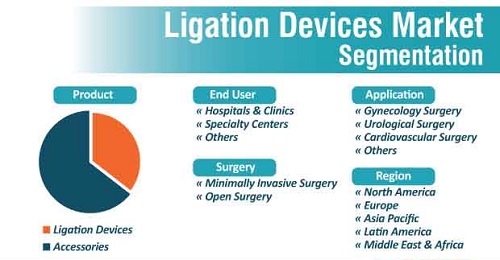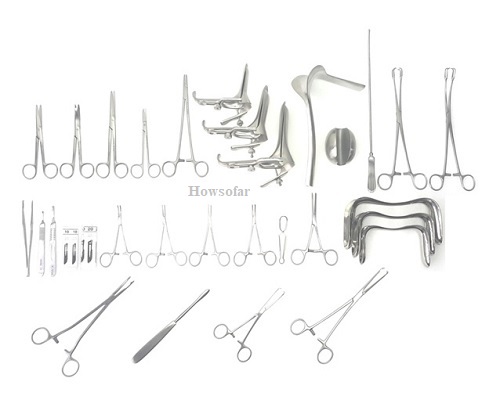Surgical procedures have significantly evolved over the years, thanks to advancements in medical technology. One critical aspect of surgeries is the use of ligation devices, which play a pivotal role in sealing blood vessels or ducts to control bleeding. These devices ensure that the surgical site remains bloodless, making it easier for surgeons to perform complex procedures. The ligation devices market has witnessed substantial growth and is expected to continue its upward trajectory.

Understanding Ligation Devices
Ligation devices are surgical instruments used to ligate or tie off blood vessels or other tubular structures during surgical procedures. They are designed to achieve hemostasis, preventing excessive bleeding and reducing the risk of complications. These devices come in various forms, such as hemostats, ligating clips, sutures, and staples, among others. The choice of ligation device depends on the nature of the surgery and the surgeon’s preference.
Market Overview
1 Growth in Surgical Procedures
The increasing prevalence of chronic diseases and the aging population have led to a rise in surgical interventions worldwide. Additionally, technological advancements have made surgeries safer and more effective, encouraging more people to undergo surgical treatments.
2 Advancements in Medical Technology
Advancements in medical technology have revolutionized surgical procedures. The integration of robotics, advanced imaging techniques, and real-time monitoring systems has significantly improved surgical outcomes. As a result, the demand for sophisticated ligation devices has also increased.
Key Players in the Ligation Devices Market
The ligation devices market is highly competitive, with several key players dominating the industry. Some of the prominent companies operating in this sector include:

1 Ethicon
Ethicon, a subsidiary of Johnson & Johnson, is a renowned name in the medical device industry. The company offers a wide range of ligation devices known for their precision and reliability.
2 Teleflex Incorporated
Teleflex Incorporated specializes in developing innovative medical solutions, including ligation devices, that cater to the needs of healthcare professionals and patients alike.
3 Olympus
Olympus is a global leader in the healthcare industry, offering advanced ligation devices and endoscopy equipment that enhance the efficiency of surgical procedures.
4 Applied Medical
Applied Medical focuses on the development of minimally invasive surgical devices, including ligation instruments, to provide better patient outcomes.
5 ConMed
ConMed is a well-known manufacturer of surgical devices, including ligation equipment, catering to various medical specialties.
6 Cooper Surgical
Cooper Surgical offers a diverse portfolio of medical devices, including ligation devices, to address the evolving needs of the healthcare industry.
Visit: Health Screening for NYC DOE Schools: A Comprehensive Guide
Market Size and Growth Potential
1 Current Market Scenario
The ligation devices market has experienced significant growth in recent years, owing to the increasing number of surgical procedures and the demand for advanced medical instruments.
2 Factors Driving Market Growth
Several factors contribute to the growth of the ligation devices market:
- Rising incidence of chronic diseases and age-related conditions
- Technological advancements in surgical procedures
- Growing awareness among healthcare professionals about the benefits of ligation devices
- Expanding healthcare infrastructure in developing economies
3 Forecast for the Ligation Devices Market
The ligation devices market is poised for robust growth in the coming years. Technological innovations, coupled with a rising number of surgical procedures, will drive market expansion.
Types of Ligation Devices
Ligation devices come in various types, each serving a specific purpose in surgical procedures:

1 Hemostat
Hemostats are designed to control bleeding by promoting coagulation at the surgical site. They are commonly used in open surgeries and provide temporary hemostasis.
2 Ligating Clips
Ligating clips are small, implantable devices used to occlude blood vessels or ducts permanently. They are widely used in minimally invasive procedures.
3 Sutures
Sutures are stitches used to close incisions or wounds. They play a crucial role in ensuring wound healing and reducing the risk of infection.
4 Staples
Staples are metal or plastic devices used to close incisions quickly. They are commonly used in surgeries involving the gastrointestinal tract.
5 Elastic Bands
Elastic bands are utilized in procedures where a temporary occlusion is required. They are flexible and easy to apply.
6 Ligating Loops
Ligating loops are absorbable sutures that provide temporary occlusion and are gradually absorbed by the body.
Applications of Ligation Devices
Ligation devices find applications in various surgical specialties, including:
1 General Surgery
In general surgery, ligation devices are used to control bleeding during procedures such as appendectomies, hernia repairs, and gallbladder removals.
2 Gynecological Procedures
Gynecological surgeries, such as hysterectomies and ovarian cyst removals, often require the use of ligation devices for precise hemostasis.
3 Cardiovascular Surgeries
In cardiovascular surgeries, ligation devices are used to seal blood vessels and ensure optimal outcomes for patients.
4 Orthopedic Surgeries
Orthopedic surgeries involving bones and joints may require ligation devices to control bleeding and enhance the healing process.
Advantages and Limitations of Ligation Devices
1 Advantage
Ligation devices offer several advantages, including:
- Precise and targeted hemostasis
- Minimization of bleeding-related complications
- Faster surgical procedures
- Enhanced surgical outcomes
2 Limitations
Despite their benefits, ligation devices have some limitations, such as:
- The learning curve for surgeons in using specific devices
- Potential for device-related complications
- Incompatibility with certain anatomies
Market Trends and Innovations
1 Minimally Invasive Procedures
The trend towards minimally invasive surgeries has driven the development of ligation devices that can be used through small incisions, reducing patient discomfort and recovery time.
2 Integration of Robotics
The integration of robotics in surgical procedures has led to the development of robotic-assisted ligation devices, offering greater precision and control to surgeons.
3 Biodegradable Ligation Devices
The emergence of biodegradable ligation devices ensures that the body absorbs the material over time, reducing the need for device removal.
4 Increasing Demand in Developing Countries
As healthcare infrastructure improves in developing countries, the demand for ligation devices is expected to rise significantly.
Regulatory Landscape and Quality Control
The manufacturing and distribution of ligation devices are regulated by health authorities to ensure their safety and efficacy. Manufacturers must adhere to strict quality control standards to maintain the integrity of these devices.
Challenges in the Ligation Devices Market
1 High Cost of Advanced Devices
The cost of advanced ligation devices may limit their accessibility, particularly in resource-constrained healthcare settings.
2 Product Recalls and Safety Concerns
Occasional product recalls and safety concerns pose challenges to manufacturers and healthcare providers, necessitating continuous improvement in product quality.
Competitive Outlook
The ligation devices market is highly competitive, with key players employing various strategies to maintain their market share and gain a competitive edge.
1 Strategic Collaborations and Partnerships
Companies often collaborate with research institutions and other industry players to develop innovative ligation devices and expand their product portfolios.
2 Product Launches and Innovations
Continuous product innovations and launches help companies stay ahead in the market and cater to evolving customer needs.
Future Perspectives and Opportunities
The future of the ligation devices market looks promising, with opportunities for growth in emerging economies and advancements in surgical techniques.
Conclusion
Ligation devices have become indispensable tools in modern surgical procedures, ensuring effective hemostasis and improved patient outcomes. The market for these devices is witnessing substantial growth, driven by advancements in medical technology and the increasing number of surgical interventions worldwide. Key players in the industry are continuously innovating and collaborating to provide cutting-edge solutions to healthcare professionals.
FAQs
1. What are ligation devices?
Ligation devices are surgical instruments used to ligate or tie off blood vessels or tubular structures during surgical procedures to control bleeding.
2. How do ligation devices contribute to surgical outcomes?
Ligation devices ensure precise hemostasis, reducing bleeding-related complications and improving surgical outcomes.
3. What types of ligation devices are available?
There are various types of ligation devices, including hemostats, ligating clips, sutures, staples, elastic bands, and ligating loops.
4. Which surgical specialties use ligation devices?
Ligation devices find applications in general surgery, gynecological procedures, cardiovascular surgeries, and orthopedic surgeries, among others.
5. What are the challenges in the ligation devices market?
The high cost of advanced devices and occasional product recalls pose challenges to the market’s growth and stability.



